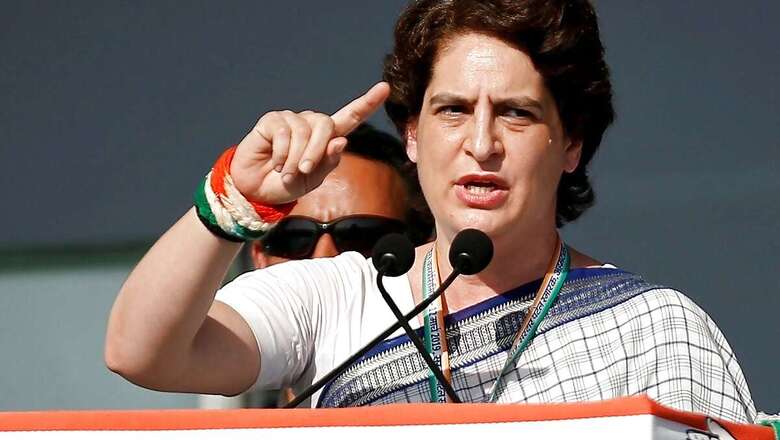
views
In a recently held virtual meeting with representatives of the Muslim community, senior Congress leader and chairman of the party’s communications department in Uttar Pradesh, Naseemudin Siddiqui, made headlines by appealing to them to join hands with his party, so the BJP can again be “pushed back to the situation when it had just two seats in Parliament”. Siddiqui was referring to the 1984 general elections when the Bharatiya Janata Party could send just two lawmakers to the Lok Sabha and its long march ahead was yet to unfold.
For many political watchers, Siddiqui’s comment had no relevance or it was read more as political hyperbole. But for the Congress’s poll managers, it is all part of the party’s larger UP campaign strategy. A move that aims to reclaim the lost Muslim vote bank that for long had more or less been aligned with the Samajwadi Party.
For the grand old party, it was the firm coalition of the Muslims, Dalits and Brahmins that had kept it in power for decades since Independence till the mid-1980s, before the rising tide of “Mandal and Kamandal politics” withered it away. As the BJP gained momentum, riding on the Ram temple movement and increasingly dominating Hindutva ideology, Muslims gradually shifted towards the Samajwadi Party, which under the leadership of socialist stalwart Mulayam Singh Yadav emerged as the biggest political force opposing the BJP.
The Samajwadi party with its strong presence among the backward castes, especially the Yadavs, seemed a natural choice against the BJP. It gradually gave rise to the formidable “M-Y (Muslim-Yadav) factor”. Decades later, this factor still works well for the SP under the leadership of Akhilesh Yadav and gives it the crucial, formidable foundation around which other castes and, in general, non-BJP voters can look to consolidate.
How UP politics changed
For decades now, either overtly or covertly, electoral politics in Uttar Pradesh ultimately has boiled down to the caste and communal equations. The consolidation of Hindus cutting across caste lines has been a big myth. Had it not been so, the BJP would have returned to power in the assembly elections after the demolition of the Babri mosque in 1992. Since then until the 2012 assembly polls, the party faced setbacks only because it couldn’t work out the caste calculations.
Starting from the 2014 Lok Sabha polls, the BJP in Uttar Pradesh got its caste equations right and in the 2017 assembly elections saw a landslide victory. The BJP’s formidable consolidation of the upper castes, non-Yadav OBCs and the non-Jatav Dalits, all under the larger umbrella of Hindutva, had worked perfectly well. The party got almost 40 per cent of the popular vote, which was around 25 per cent higher than the votes polled in 2012.
The Samajwadi Party on the other hand was reduced to 47 seats from 224 in 2012, and almost 22 per cent vote share. The mighty Bahujan Samaj Party could get only 19 seats and the Congress just seven with less than six per cent vote share. Clearly, while the SP was to an extent able to preserve its Muslim-Yadav vote base, Mayawati was left mostly with her core Jatav-Dalit vote and the Congress without any base.
In today’s political scenario, while no opposition party can openly dare to play the minority card, the fact remains that it is desperately needed by all non-BJP players. Constituting around 19 per cent of the state’s population, Muslims are a large vote bank, and in their biggest concern to counter the BJP, they are also seen as a big, homogenous voting bloc. Even in the often-discussed M-Y formula, Yadavs are estimated to be only between six to eight per cent.
Lucknow-based sociologist Dr Pradeep Sharma says, “In the context of the 2022 assembly polls, Muslims can play the role of the magnet for any castes or communities that may have been antagonised by the BJP.” He explains that in the politics of competing caste aspirations and amid reports of Brahmin discontent and grumblings within the most backward castes under chief minister Yogi Adityanath’s rule, opposition parties will clearly hope to capitalise on them around the firm Muslim vote base.
Congress’s pivotal bid
Desperate to reclaim the space again in Uttar Pradesh, the Congress, therefore, now wants to make inroads among the Muslims, even if it means countering the Samajwadi Party. The campaign, which the party is taking forward leaves no doubt about that.
In a series of meetings and outreach being organised by the party, the emphasis is on what the Congress feels is the ever-existent tacit understanding between the BJP and the Samajwadi Party. Mulayam Singh Yadav’s unforgettable blessing to Prime Minister Narendra Modi ahead of the 2019 general elections is frequently talked about. Questions are raised on the SP’s silence on the issue of Rampur MP Azam Khan’s alleged victimisation by the ruling BJP.
Speaking to News18, Shahnawaz Alam, chairman of Congress’s UP minority wing, said, “The SP has always used the Muslims as a vote bank and never actually shared power with them. The secret understanding between the BJP and the SP has now been exposed. No one can forget that it was Priyanka Gandhi who came forward to stand with innocent victims of the state repression following the anti-CAA protests. In our fight against the BJP, it is also necessary to expose the pseudo-secular character of the Samajwadi Party. As an opposition party, we are here to work on our strategy and no one should be offended by that.”
The SP, however, remains unfazed by the Congress’s campaign strategy. Party legislator Udaiveer Singh says, “No one can stop Congress leaders from daydreaming and building castles in the air. Our party has been at the forefront of fighting both the anti-people policies and the communal politics of the BJP. Yogi Adityanath’s government has disrupted the development and social harmony in the state and people will stand with the Samajwadi Party in the coming elections.”
Read all the Latest News, Breaking News and Coronavirus News here.



















Comments
0 comment